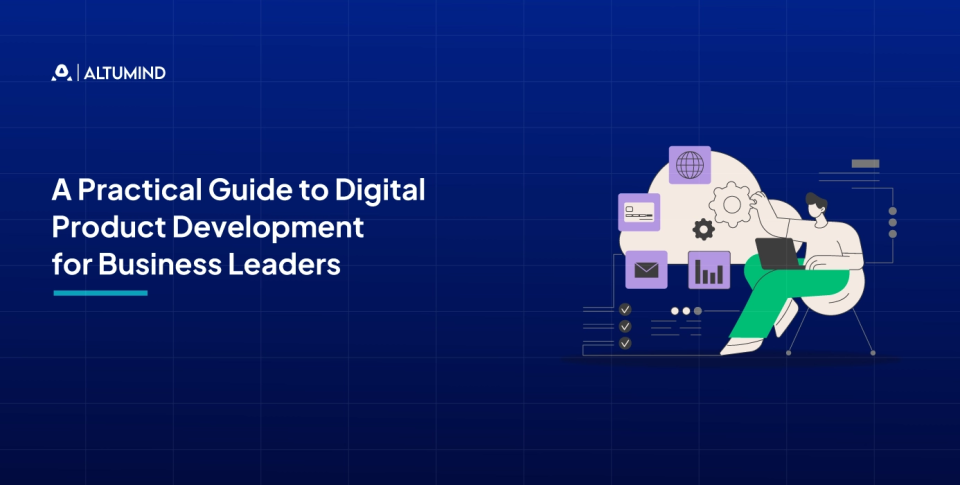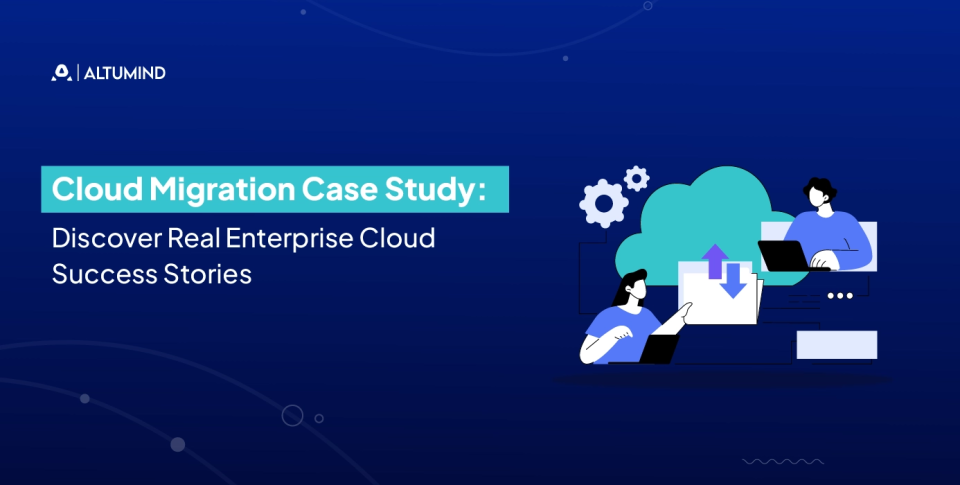Cloud Management Outsourcing: The Key Driver Behind Modern Business Agility
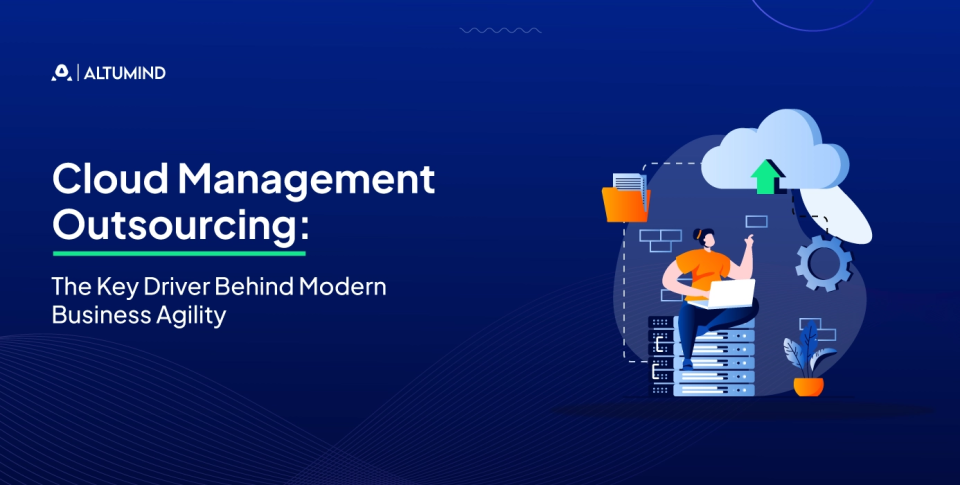
Managing the cloud is no longer simple. As organizations expand across multiple platforms, the responsibility to maintain security, performance, and compliance grows faster than internal teams can handle.
Each environment requires unique expertise, constant updates, and round-the-clock supervision. What once promised flexibility often becomes an operational weight that drains both time and budgets.
Leaders see the effects clearly. Rising costs, delayed innovation, and ongoing operational challenges limit strategic focus. Skilled engineers spend valuable hours monitoring systems instead of developing new solutions. Departments start competing for resources while compliance risks increase quietly in the background.
Cloud management outsourcing shifts this burden to specialized partners who maintain, optimize, and secure complex infrastructures with precision. So if you’re curious to explore its capabilities, keep reading. In this article, we will understand what cloud management outsourcing truly means and why it has become a strategic choice for forward-thinking enterprises.
What is Cloud Management Outsourcing?
Cloud management outsourcing is the strategic partnership between an enterprise and a specialized provider to supervise, secure, and optimize its cloud operations. Instead of building large in-house teams, organizations rely on experts who bring dedicated skills across multiple platforms, including public, private, and hybrid models. These teams handle the daily orchestration of workloads, security frameworks, and performance benchmarks with consistency and precision.
The momentum around outsourced cloud management is growing fast. The global cloud industry recorded strong double-digit growth in 2024 and is projected to almost double in value before 2030. North America continues to account for the largest share of enterprise adoption, while India is predicted to experience the steepest rise in demand, reflecting its expanding digital infrastructure and growing base of technology-driven enterprises. This trend underlines how companies are viewing the cloud not just as a tool but as a business enabler that requires expert stewardship.
Forward-looking organizations now treat outsourcing as part of enterprise IT solutions that drive digital transformation success. By engaging trusted partners, they gain operational clarity, faster deployment, and higher resilience while keeping innovation at the center of their strategy.
Scope of Services
- Cloud Resource Management: Supervision of capacity, workloads, and configurations to maintain stable performance across varied environments.
- Security and Compliance Management: Constant auditing, access control, and adherence to global data protection standards.
- Cost Optimization: Financial transparency through predictive models that balance usage with efficiency.
- Performance Monitoring: Ongoing visibility into response times, availability, and application behavior through intelligent analytics.
- Automation and DevOps Enablement: Streamlined updates, testing, and delivery cycles supported by robust frameworks.
- Backup and Recovery Systems: Continuous data protection and restoration protocols that sustain business continuity.
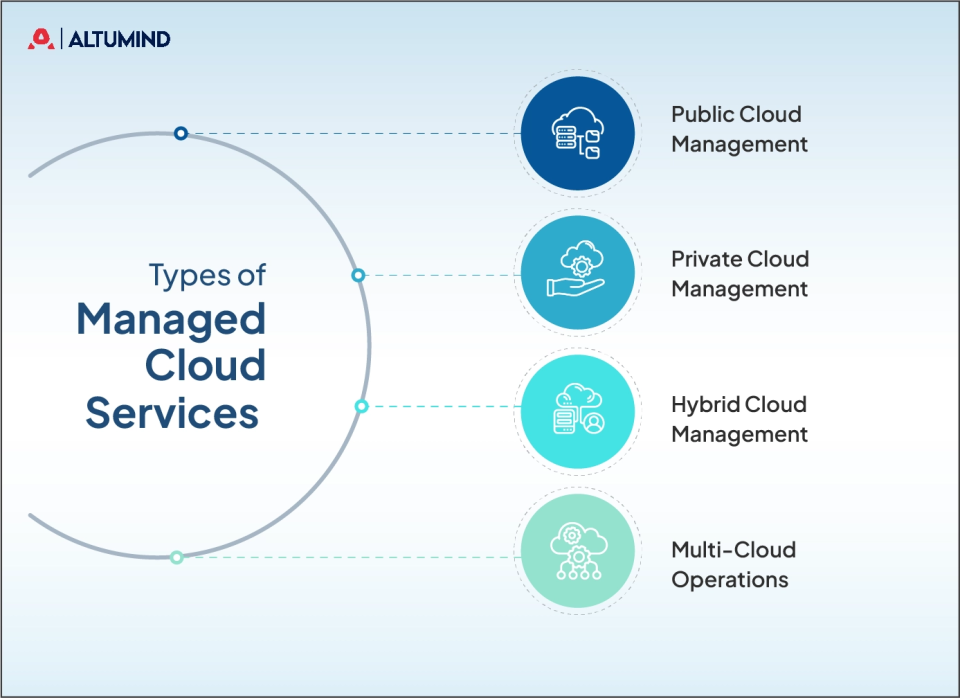
Types of Managed Cloud Services
Cloud management outsourcing covers a broad range of managed services designed to keep digital ecosystems secure, scalable, and efficient. The right mix depends on the organization’s goals, infrastructure size, and data sensitivity.
- Public Cloud Management: Focuses on platforms such as AWS, Azure, and Google Cloud, where providers handle configuration, monitoring, and resource optimization to maintain speed and cost balance.
- Private Cloud Management: Supports industries that demand strict data control, such as banking, healthcare, and government. It delivers dedicated infrastructure with compliance frameworks and advanced security controls.
- Hybrid Cloud Management: Blends private and public environments, allowing businesses to operate sensitive workloads in a controlled setup while keeping scalable resources available on demand.
- Multi-Cloud Operations: Offers companies freedom from vendor dependency by unifying several cloud platforms through a centralized control layer. This model enhances flexibility and performance visibility across systems.
Together, these managed cloud services form the foundation of modern cloud outsourcing, helping organizations manage complex infrastructures with confidence, improve agility, and achieve measurable value through intelligent cloud resource management.
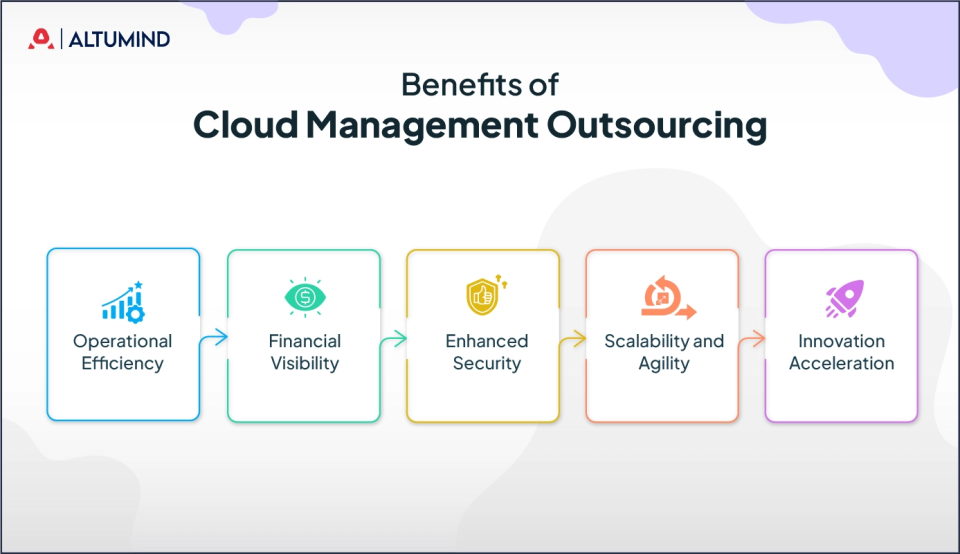
Benefits of Cloud Management Outsourcing
The value of cloud management outsourcing extends far beyond reducing operational pressure. It acts as a catalyst for innovation, resilience, and measurable business outcomes. Organizations that delegate cloud operations to experienced partners gain clarity, efficiency, and the freedom to innovate.
According to recent research by Infosys, cloud adoption aimed at driving organizational growth and transformation is viewed as three times more significant than using the cloud solely for cost savings, and about 73% of business leaders believe that cloud migration directly supports their strategic objectives. These findings reflect how enterprises are shifting from viewing the cloud as a cost tool to recognizing it as a core driver of transformation.
Outsourcing cloud management has benefits including:
- Operational Efficiency:
By handing over daily monitoring, patching, and load balancing to dedicated specialists, companies reduce downtime and human error. Outsourced teams use advanced automation to handle updates, allowing in-house IT to focus on developing new capabilities and supporting digital products that add measurable business value. - Financial Visibility:
Managed service providers use FinOps-driven models and detailed usage analytics to control expenses. Instead of unplanned cloud costs, businesses gain predictable billing and insights into where resources can be consolidated or repurposed for better returns. - Enhanced Security:
Security in cloud ecosystems is continuous and complex. External teams bring certified expertise in encryption, identity management, and regulatory compliance. Regular audits and real-time threat detection keep workloads protected while meeting standards like SOC 2, HIPAA, and GDPR. - Scalability and Agility:
With managed partners handling cloud infrastructure, scaling resources up or down becomes seamless. Whether launching a new app or handling seasonal demand, businesses get instant flexibility without overprovisioning or performance loss. - Innovation Acceleration:
When technical maintenance shifts to a trusted provider, internal teams gain the space to innovate. They can integrate AI, analytics, or automation tools faster, improving customer experiences and expanding market reach.
In-House vs. Cloud Management Outsourcing
| Aspect | In-House Cloud Management | Cloud Management Outsourcing |
|---|---|---|
| Cost Efficiency | High overheads for staffing, training, and tools | Predictable expenses with scalable subscription-based models |
| Expertise | Limited to internal skills and availability | Access to certified specialists across multi-cloud environments |
| Scalability | Dependent on team size and infrastructure capacity | Instantly scalable with on-demand resource allocation |
| Security and Compliance | Reactive measures managed internally | Proactive monitoring with continuous compliance enforcement |
| Innovation Focus | Teams spend time maintaining systems | IT focuses on business growth and product innovation |
| Performance Monitoring | Manual tracking and slower incident response | Automated analytics with real-time visibility and alerts |
| Business Continuity | Greater risk of downtime and human error | Built-in disaster recovery and 24x7 managed support |
| Time to Deploy | Longer implementation cycles | Accelerated delivery through automation and best practices |
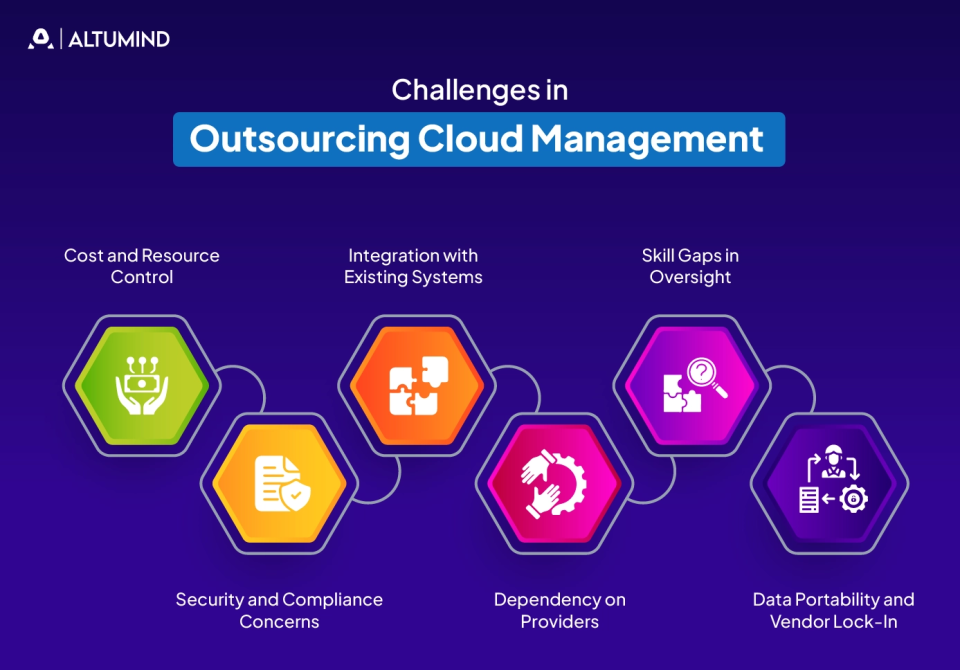
Key Challenges in Outsourcing Cloud Management
While cloud management outsourcing offers operational efficiency, cost visibility, and continuous innovation, enterprises often face a few practical hurdles before realizing its full potential. Addressing these challenges early helps transform a managed services model into a long-term strategic advantage.
Cost and Resource Control
Studies indicate that 84% of organizations face difficulty managing cloud spend. Outsourcing without a defined financial framework can lead to overspending and unpredictable invoices. Many enterprises underestimate how unused resources, shadow IT, and fragmented billing affect budgets. Partnering with a provider that applies FinOps principles and automated usage analytics allows real-time visibility and precise cost alignment with business goals.
Security and Compliance Concerns
Nearly 77% of decision-makers identify security as a critical challenge in managing external cloud operations. The distributed nature of hybrid and multi-cloud setups makes maintaining compliance across regions complex. Advanced AI in compliance is now playing a key role in addressing this issue, offering automated risk assessments, policy updates, and continuous monitoring. However, it still demands a joint approach where both internal and outsourced teams share responsibility for safeguarding data and maintaining audit readiness.
Integration with Existing Systems
Legacy infrastructures often limit cloud adaptability. Many companies move workloads to the cloud but continue to rely on outdated on-premises applications, leading to operational silos. Without effective integration across these environments, overall efficiency and business agility decline. A strong integration plan supported by APIs, automation, and cross-platform visibility ensures seamless coordination between legacy systems and modern architectures.
Dependency on Providers
Outsourcing introduces reliance on external partners for uptime, updates, and compliance. If communication frameworks or escalation paths are insufficiently defined, even minor issues can delay responses. Businesses can counter this by maintaining shared dashboards, setting measurable KPIs, and conducting joint performance reviews that hold both teams accountable for service continuity.
Skill Gaps in Oversight
Even when providers manage most of the operational work, enterprises must retain the ability to interpret performance data, cost reports, and compliance updates. Without foundational internal knowledge, leadership teams may struggle to validate insights or challenge recommendations. Continuous internal training and shared knowledge transfer programs bridge this skill gap and promote smarter decision-making.
Data Portability and Vendor Lock-In
Moving workloads between providers or geographic regions remains technically demanding. Inconsistent data formats and compliance rules can lead to downtime or data loss. Designing a vendor-neutral architecture from the start, supported by standardized APIs and multi-cloud frameworks, helps maintain flexibility for future transitions.
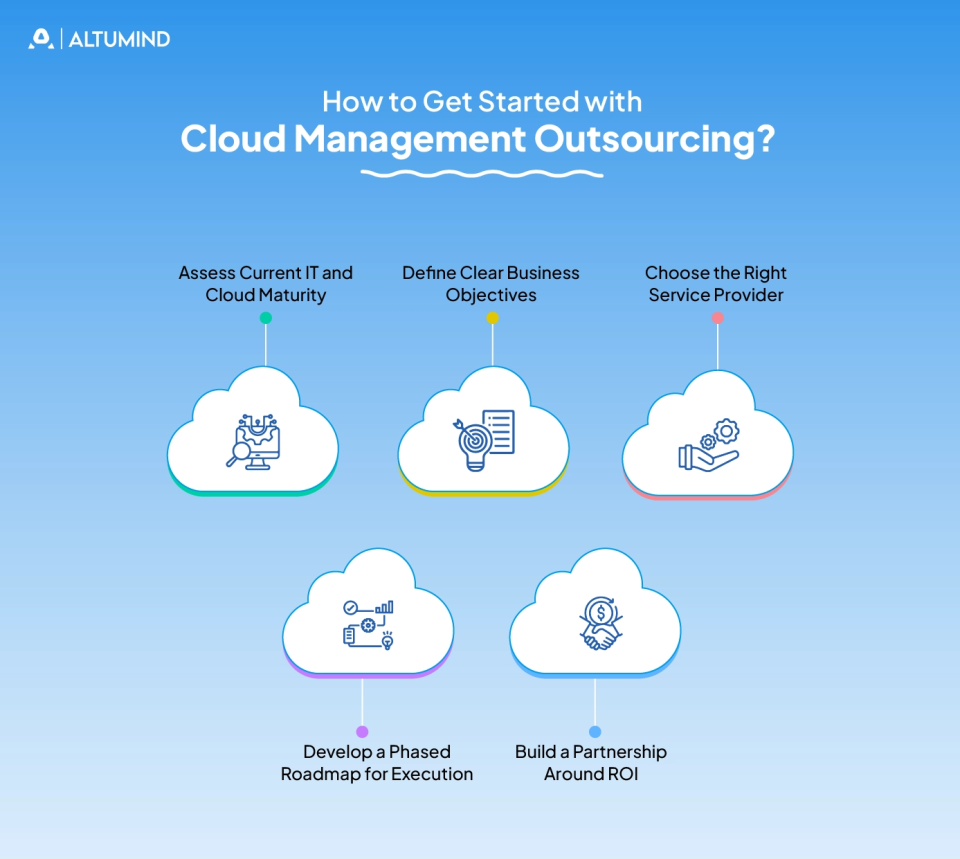
How to Get Started with Cloud Management Outsourcing
Adopting cloud management outsourcing is a strategic decision that requires clarity, structure, and the right technology partner. The goal is to balance control and flexibility while gaining measurable business outcomes. Below is a structured approach to begin this journey confidently.
Assess Current IT and Cloud Maturity
Start by analyzing your existing cloud ecosystem. Review workloads, configurations, and integration layers to identify where gaps exist. This evaluation should highlight challenges such as fragmented tools, limited automation, or inconsistent performance across platforms.
- Document your team’s skill levels and current vendor dependencies.
- Identify workloads that demand constant monitoring or specialized compliance support.
- Map out pain points such as cost overruns or system downtime that disrupt productivity.
This assessment sets a clear baseline for what needs to be managed internally and what should be outsourced for efficiency.
Define Clear Business Objectives
Outsourcing works best when aligned with precise goals. Ask how outsourcing supports your broader business outcomes.
- For cost reduction, look for transparent billing models and performance-linked pricing.
- For agility, focus on faster provisioning and proactive monitoring that minimize delays.
- For innovation, choose partners that bring automation, AI insights, and cloud-native development expertise.
Setting priorities at this stage prevents scope drift and creates a measurable direction for transformation.
Choose the Right Service Provider
Selecting a provider goes beyond technical qualifications. Evaluate how their capabilities complement your goals.
- Assess their experience with multi-cloud and hybrid environments.
- Check compliance credentials across standards such as SOC 2, HIPAA, or GDPR.
- Review case studies that reflect similar operational challenges or industries.
Providers that combine automation, analytics, and performance benchmarking will add long-term value to your operations.
Develop a Roadmap for Execution
Once goals and partners are defined, structure the engagement into a practical, phased roadmap. This reduces risk and allows measurable progress at every stage. The process typically involves four key phases:
- Assessment: Evaluate workloads, compliance needs, and technical dependencies.
- Migration: Transfer applications and data using secure, low-disruption methodologies.
- Management: Deploy continuous monitoring, cost control, and governance frameworks.
- Optimization: Refine cloud performance through data analytics and AI-driven insights.
Each phase should include review checkpoints, SLA validations, and measurable KPIs to maintain alignment between business and technology outcomes.
Build a Partnership Around ROI
The final step focuses on sustained value. True outsourcing success depends on a partner that understands both technical depth and business impact. At Altumind, we combine automation, multi-cloud expertise, and real-time performance visibility to deliver quantifiable results.
By forming a partnership based on trust, transparency, and measurable returns, organizations can transform managing cloud infrastructure into a growth engine that consistently supports innovation and long-term competitiveness.
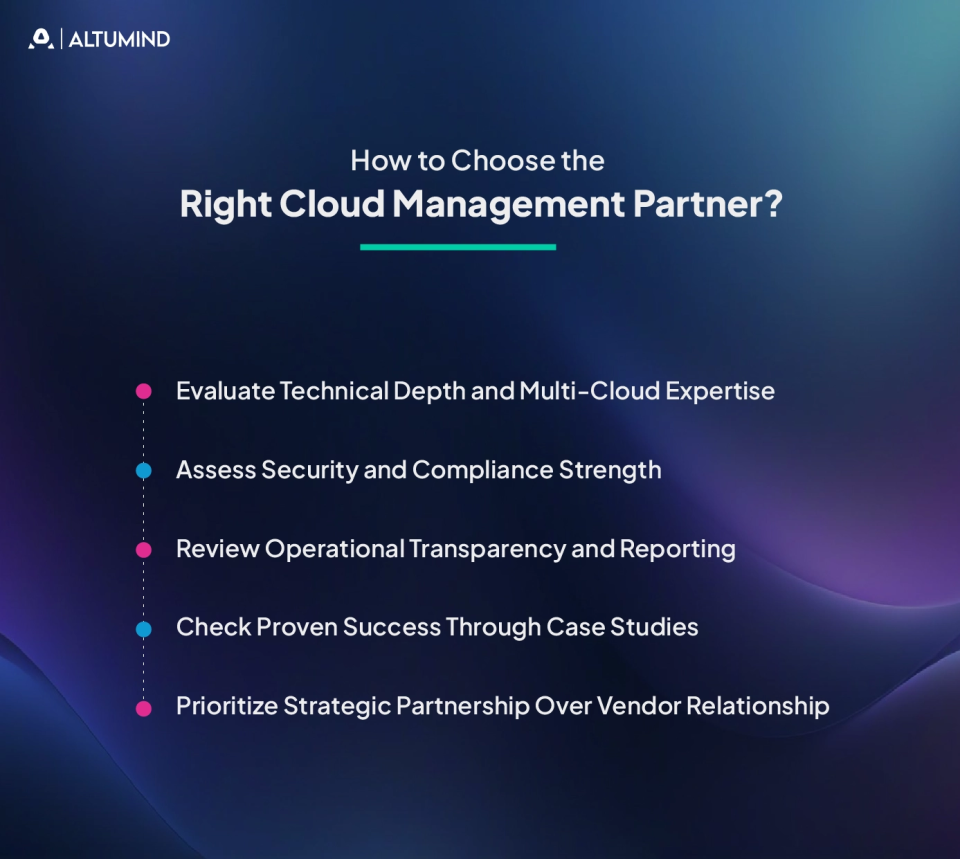
How to Choose the Right Cloud Management Partner?
Selecting the right partner for cloud management outsourcing is a decision that shapes both the stability and scalability of your operations. The ideal provider should not only manage infrastructure but also contribute to innovation, compliance, and measurable growth. Here’s how to make that choice with confidence.
Evaluate Technical Depth and Multi-Cloud Expertise
A credible partner should demonstrate hands-on experience across public, private, and hybrid cloud management environments. Review their certifications with platforms such as AWS, Azure, and Google Cloud, along with their approach to automation, AI monitoring, and cost analytics. Providers that deliver structured resource optimization and intelligent workload management help maintain consistent performance and improve overall operational efficiency.
Assess Security and Compliance Strength
Your partner should offer built-in data protection, risk monitoring, and compliance frameworks aligned with standards like HIPAA, GDPR, and SOC 2. Ask how they handle access control, data residency, and real-time alerts. A provider that embeds predictive monitoring and AI-driven compliance into their managed operations can prevent issues before they impact performance.
Review Operational Transparency and Reporting
Regular reporting builds accountability. The provider should deliver detailed insights into uptime, spending patterns, and performance metrics through centralized dashboards. Look for a model that supports collaborative visibility, where your internal teams can track cloud activity, costs, and compliance status without dependency on external approvals.
Check Proven Success Through Case Studies
Authentic results speak louder than sales claims. Request performance metrics and real-world examples that demonstrate their expertise. For instance, cloud-basedcase studies discussing improved uptime, optimized cost, and enhanced data security will validate the partner’s ability to manage large-scale transformation efficiently.
Prioritize Strategic Partnership Over Vendor Relationship
Choose a partner that acts as an extension of your technology team. The best collaborations go beyond system management and focus on driving innovation, automation, and ongoing business improvement. Providers that deliver ongoing optimization while demonstrating the benefits of managed IT services enable organizations to achieve higher efficiency, sustain innovation, and align every technology investment with long-term business growth.
Trends and Future Outlook
The future of cloud management outsourcing is defined by innovation, automation, and a growing emphasis on sustainable performance. As enterprises deepen their digital maturity, outsourcing models are evolving to support smarter, faster, and more resilient cloud operations.
- Intelligent Cloud Automation
Artificial intelligence and machine learning are reshaping how providers monitor and optimize cloud systems. Predictive tools can detect performance anomalies, balance workloads, and automate routine maintenance, resulting in faster response times and fewer service disruptions. - Integrated Multi-Environment Operations
Organizations are increasingly combining private and public infrastructures to achieve agility and control. Modern providers are introducing unified management frameworks that oversee every environment from a single interface, reducing complexity and improving coordination across platforms. - Sustainability as a Core Priority
Environmental accountability is now influencing IT strategy. Providers are designing energy-efficient data centers, optimizing compute usage, and adopting carbon-aware routing to support global sustainability goals. Businesses now view green operations as a measurable performance metric rather than a marketing goal. - Automated Governance and Security
With data regulations becoming more stringent, automation is essential for continuous compliance. Intelligent monitoring tools now evaluate security posture, manage policy updates, and generate detailed audit trails in real time, minimizing manual intervention and improving reliability. - Outcome-Focused Service Models
The next generation of outsourcing will emphasize results over resources. Enterprises will expect measurable outcomes such as reduced downtime, faster deployment, and consistent cost savings. This approach shifts partnerships from transactional contracts to strategic collaborations focused on business impact.
Conclusion
The complexity of managing diverse cloud environments has made cloud management outsourcing an essential strategy for organizations focused on agility, security, and sustainable growth. Engaging expert partners allows enterprises to streamline operations, reduce overheads, and strengthen their digital infrastructure without losing visibility or control.
As businesses continue to scale, they need more than operational support; they need innovation built into every layer of their technology stack. Providers offering cloud application development services help enterprises modernize systems, improve efficiency, and respond quickly to market demands.
Altumind combines proven technical expertise with deep industry experience to deliver results that matter. With a strong foundation in fully managed IT services, multi-cloud management, and end-to-end transformation, Altumind empowers businesses to achieve measurable outcomes, improved performance, and sustained digital resilience.
Table of Contents
- Introduction
- What is Cloud Management Outsourcing?
- Benefits of Cloud Management Outsourcing
- In-House vs Cloud Management Outsourcing
- Key Challenges in Outsourcing Cloud Management
- How to Get Started with Cloud Management Outsourcing
- How to Choose the Right Cloud Management Partner?
- Trends and Future Outlook
- Conclusion
Let's Connect
Reach out and explore how we can co-create your digital future!


